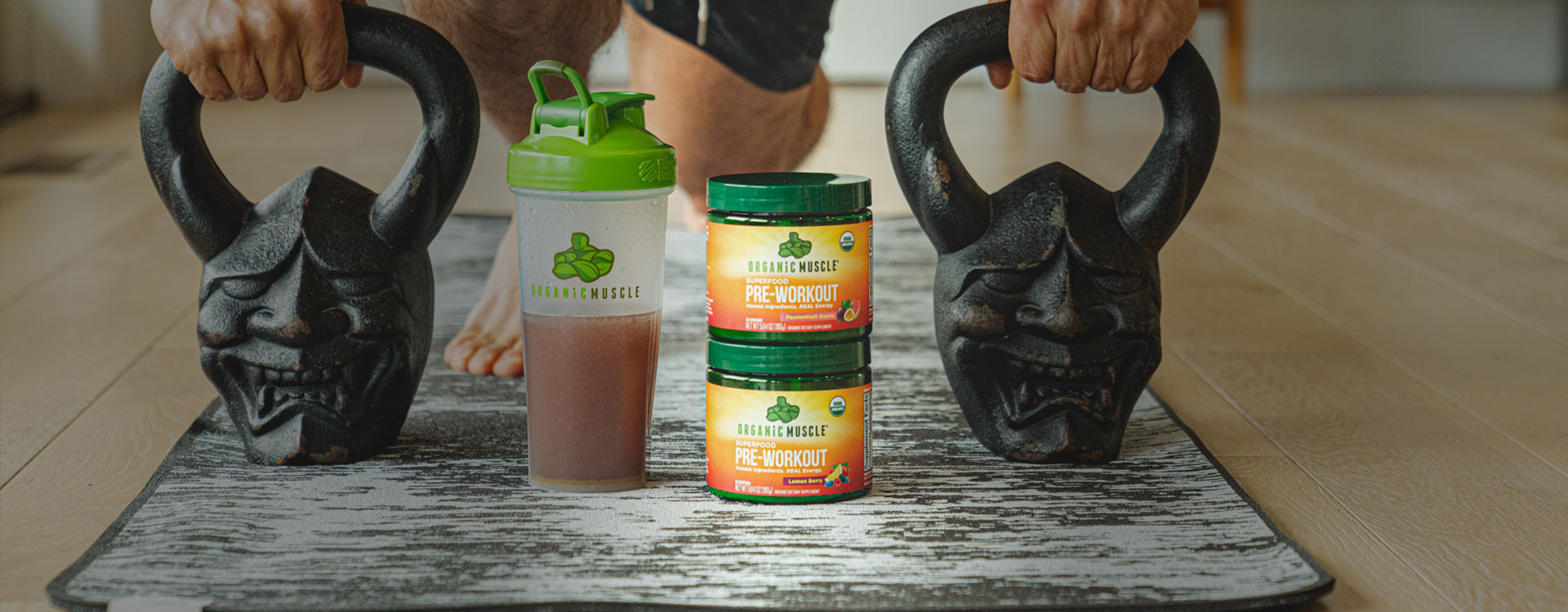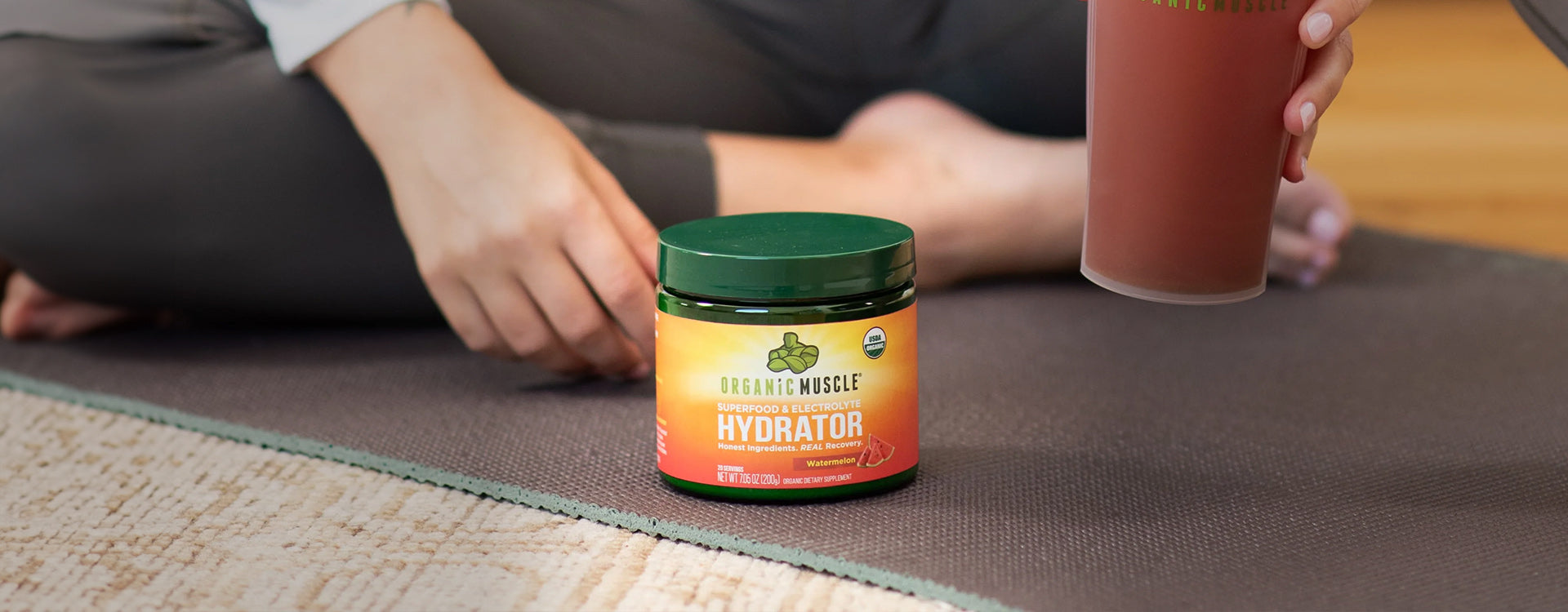Key Takeaways:
- Lower back workouts improve posture, reduce pain, and enhance core stability, benefiting daily activities and athletic performance.
- Strengthening the lower back decreases injury risks and boosts balance and coordination, making it essential for long-term physical health.
- Consistency, proper form, and gradual intensity are crucial for maximizing the benefits of lower back exercises while preventing injuries.
Strengthening the lower back is crucial for a robust and resilient body framework in fitness and health. The lower back, a pivotal area that supports everyday movements and your core, often gets overlooked until discomfort or injury reminds us of its importance. It's time to prioritize this key component of our body's structure, ensuring a stable and strong core that supports a lifetime of movement and activity.
At Organic Muscle, we understand that the journey to optimal health encompasses what we put into our bodies and how we maintain and enhance our physical form. The lower back workouts we are about to explore are designed not just for fitness enthusiasts but for anyone aiming to improve their overall well-being. These exercises promote strength, stability, flexibility, and endurance in the lower back, contributing to a healthier, more vibrant lifestyle.
Top Benefits Of Lower Back Workouts For Overall Health And Performance
Integrating lower back workouts into your fitness regime can transform your health and performance. These exercises strengthen the muscles in the lower back and contribute to a stabilizing core, which is foundational for executing daily activities and advanced athletic endeavors. Below, we explore the multifaceted benefits of dedicating time to lower back conditioning.
Enhanced Posture and Reduced Pain
One of the most significant benefits of lower back workouts is the improvement in posture. A strong lower back supports the spine better, allowing you to maintain a natural, upright alignment. This can significantly reduce discomfort and lower the risk of chronic pain conditions, often due to weak back muscles and poor posture.
Increased Core Stability
The muscles in the lower back are integral to the core, working in tandem with the abdominals, obliques, and pelvic muscles. Strengthening these muscles through targeted exercises enhances the overall stability of the core. This improvement in core stability is essential for athletic performance and pivotal for executing everyday movements efficiently and safely.
Improved Athletic Performance
Strong lower back muscles can benefit athletes across disciplines. Enhanced lower back strength translates to better power and efficiency in various movements, from running to jumping and lifting. This can lead to noticeable improvements in performance, be it generating more power in a cyclist's pedal stroke or ensuring a swimmer maintains optimal body alignment in the water.
Reduced Risk of Injury
A strong lower back is your best defense against the risk of injuries, particularly those related to the musculoskeletal system. Regular lower-back workouts increase muscle endurance and flexibility, making you less prone to strains, sprains, and other injuries that can sideline your fitness journey. You are bulletproofing your body against potential setbacks by fortifying the lower back.
Better Balance and Coordination
Strengthening the lower back is key to enhancing balance and coordination. As these workouts improve core stability, you will find it easier to control your body's movements. This is particularly beneficial for older adults, as enhanced balance can decrease the likelihood of falls, and for athletes who engage in sports requiring high levels of agility and spatial awareness.
10 Best Lower Back Workouts For A Stable And Strong Core
Targeted workouts can alleviate discomfort and build a solid foundation for a strong core. Below, we will explore the ten best lower back workouts that promote stability, strength, and resilience.
Deadlifts
Deadlifts are a compound exercise that works the entire posterior chain, including the lower back, glutes, and hamstrings.
- How to Perform:
- Stand with feet hip-width apart, gripping a barbell or dumbbell.
- Keep your back straight and engage your core as you lift the weight by extending your hips and knees.
- Lower the weight back to the ground while maintaining control.
- Benefits: Enhances overall strength and stability in the lower back and core.
Bird Dogs
The bird dog exercise improves stability and balance while engaging the core.
- How to Perform:
- Start on all fours, hands under shoulders and knees under hips.
- Extend one arm forward and the opposite leg back while keeping your hips level.
- Hold briefly, then return to the starting position and switch sides.
- Benefits: Promotes coordination and core stability while strengthening the lower back.
Supermans
Supermans target the lower back and glutes, enhancing strength and stability.
- How to Perform:
- Lie face down with arms extended in front.
- Simultaneously raise your arms, chest, and legs off the ground, holding for a few seconds.
- Lower back down and repeat.
- Benefits: Strengthens the erector spinae muscles, crucial for a stable lower back.
Plank Variations
Planks are fundamental for core stability, engaging multiple muscle groups, including the lower back.
- How to Perform:
- Start in a push-up position with your body in a straight line.
- Hold for 30 seconds to 1 minute, engaging your core and ensuring your hips don’t sag.
- Benefits: Enhances core stability, reducing strain on the lower back during other movements.
Bridges
Bridges effectively target the glutes and lower back, contributing to overall core strength.
- How to Perform:
- Lie on your back with your knees bent and feet flat on the floor.
- Raise your hips toward the ceiling, squeezing your glutes at the top.
- Lower back down and repeat.
- Benefits: Strengthens the posterior chain and improves lower back stability.
Reverse Hyperextensions
This exercise targets the lower back while minimizing strain, which is ideal for those recovering from injuries.
- How to Perform:
- Use a reverse hyperextension machine or a sturdy bench.
- Lie face down with your hips at the edge, legs hanging off.
- Lift your legs upward, squeezing your lower back and glutes, then lower back down.
- Benefits: Increases lower back strength while promoting spinal health.
Kettlebell Swings
Kettlebell swings provide a dynamic workout for the lower back and core, enhancing power and stability.
- How to Perform:
- Stand with feet shoulder-width apart, holding a kettlebell with both hands.
- Hinge at your hips to swing the kettlebell between your legs, then explosively extend your hips to swing it to shoulder height.
- Maintain a neutral spine throughout.
- Benefits: Strengthens the lower back and improves functional movement patterns.
Side Planks
Side planks focus on the obliques and lower back, contributing to core stability.
- How to Perform:
- Lie on your side with your legs stacked and propped up on your elbow.
- Lift your hips off the ground, forming a straight line from head to feet.
- Hold for 30 seconds to 1 minute, then switch sides.
- Benefits: Enhances lateral stability and reduces the risk of back injuries.
Seated Cable Rows
Seated cable rows work the back muscles and improve posture, supporting lower back health.
- How to Perform:
- Sit at a cable machine with feet on the platform and knees slightly bent.
- Pull the cable handle toward your abdomen, squeezing your shoulder blades together.
- Return to the starting position with control.
- Benefits: Strengthens the upper and lower back, promoting a stable core.
Yoga and Stretching
Incorporating yoga poses like the cat-cow, downward dog, and child’s pose can enhance flexibility and relieve tension in the lower back.
- How to Perform:
- Practice gentle stretching routines focusing on the lower back and hips.
- Hold each pose for several breaths to promote relaxation and flexibility.
- Benefits: Improves mobility, reduces tightness, and enhances overall back health.
How To Choose The Right Lower Back Exercises For Your Fitness Level
Here are several tips to consider when choosing the right lower back exercises for your regimen:
Assess Your Current Fitness Level and Flexibility
Before starting any workout program, assess your current fitness and flexibility levels. Are lower back exercises new to you, or have you incorporated them into your routines? Knowing where you stand can help you select exercises that match your capabilities, reducing the risk of injury.
Start with the Basics
If you're new to lower back workouts, start with fundamental exercises focusing on form and technique rather than intensity. Exercises like the pelvic tilt, cat-cow stretch, and simple plank variations can establish a solid foundation. These movements help enhance your core stability and prepare your lower back for more challenging exercises.
Incrementally Increase Intensity
Once you're comfortable with basic exercises and consistently perform them with correct form, gradually increase the challenge. This can mean adding more repetitions, incorporating weights, or trying advanced movements like the deadlift or bird dog exercise. It's essential to listen to your body and progress at a challenging yet manageable pace.
Consider Any Pre-existing Conditions or Injuries
If you have a history of lower back pain or other related conditions, consult a healthcare professional before beginning any new workout routine. They can recommend specific exercises that safely align with your health goals and fitness level, ensuring you strengthen your lower back without undue strain.
Stay Consistent and Be Patient
Building a strong and stable core, especially the lower back, doesn't happen overnight. It requires dedication, consistency, and patience. Celebrate your progress, no matter how small, and remember that every workout contributes to your overall fitness journey.
Effective Techniques To Maximize Your Lower Back Workout Results
Achieving maximum effectiveness from your lower back workouts doesn't solely depend on the exercises you perform. Incorporating certain techniques into your routine can significantly enhance your results, ensuring the time spent on your fitness journey translates into tangible benefits. Here are some strategies to maximize the outcomes of your lower back workouts:
Prioritize Form Over Weight
Ensuring correct form is paramount in all exercises, especially when targeting the lower back, a region susceptible to injury. Before increasing weight or resistance, focus on mastering the movements with precision. This approach minimizes the risk of injury and ensures that the intended muscle groups are effectively engaged, promoting more significant strength gains.
Incorporate Core Stability Exercises
A strong core is the foundation of a stable and healthy lower back. Incorporating exercises that enhance core stability, such as planks or bridges, can support your lower back muscles. Such exercises improve overall balance and posture, which are crucial for everyday activities and optimizing performance in your workouts.
Progressive Overload
To continue making gains, gradually increasing the difficulty of your workouts gradually is essential. This concept, known as progressive overload, can be achieved by adding more weight, increasing repetitions, or changing the exercise to a more challenging variation. This continued progression prevents your body from hitting a plateau and ensures your lower back strengthens over time.
Focus on Mind-Muscle Connection
Being mindful of the muscle groups you are engaging during your workouts can significantly improve results. Concentrating on the contraction and release of the lower back muscles during exercises fosters a deeper connection between mind and muscle, leading to more efficient and effective workouts.
Incorporate Rest and Recovery
Rest and recovery are as crucial as the workouts themselves. Like all muscles, the muscles in your lower back need time to repair and strengthen after being exerted. Ensure adequate recovery time between sessions targeting the same muscle group to prevent overtraining and injury.
Stay Hydrated and Nourished
Proper hydration and nutrition play critical roles in muscle recovery and performance. Fueling your body with the right nutrients, including premium-quality, organic supplements from Organic Muscle, can significantly enhance your exercise capacity and recovery times. Our products, designed with your holistic wellness in mind, ensure that you're not just meeting your fitness goals but also investing in your overall health.
Addressing Commercial Intent: Best Equipment For Lower Back Workouts
Below, we have curated a list of equipment that stands out for their efficacy in lower back exercises.
Stability Balls
Stability balls are incredibly versatile and effective for a broad range of lower back workouts. Exercises such as the stability ball hyperextension or leg lift to engage the lower back muscles thoroughly while ensuring the core is activated. These balls also promote balance and improve posture, vital for a healthy lower back.
Weight Plates
For those looking to add intensity to their workouts, weight plates can be incorporated into lower back exercises. Used wisely in deadlifts or hyperextensions, they add the resistance necessary to strengthen the lower back muscles. Ensure that the appropriate weight is selected to maintain form and prevent injury.
Medicine Balls
Medicine balls can add an extra challenge to core and lower back workouts. Exercises like medicine ball slams or twists can significantly engage the lower back region, promoting strength and flexibility. They come in various weights, making them suitable for all fitness levels.
Resistance Bands
Resistance bands are an ideal choice for those who prefer or require a more gradual approach to strengthening their lower back. They offer different resistance levels, enabling a progressive increase in workout intensity. Exercises like band pull-apart or good mornings with bands help target the lower back effectively.
Yoga Mats
Safety and comfort are paramount during any workout session. A high-quality yoga mat provides a stable surface for performing lower back exercises, especially those that require ground contact, like bridges or stretches. It reduces the risk of slipping and cushions the body appropriately.
Preventing Injuries: Safe Practices For Lower Back Exercises
Here, we illustrate key strategies to ensure that your lower back workouts yield the desired results and are safe and sustainable.
- Warm-Up Thoroughly: Before engaging in any lower back exercises, preparing your body with a comprehensive warm-up routine is essential. This could involve a brisk walk, light jogging, or dynamic stretches that target the spine, hips, and legs. A proper warm-up increases blood flow to the muscles, enhancing flexibility and preventing strains.
- Prioritize Form Over Weight: Maintaining the correct form is crucial whether you're lifting weights or using your body weight for exercises. Compromising your posture to lift heavier weights can lead to significant back injuries. If you're uncertain about your form, consider consulting with a fitness professional who can provide guidance tailored to your body's needs.
- Gradually Increase Intensity: Progress in strength training should always be gradual. Sudden increases in the weight lifted or the intensity of exercises can overwhelm the lower back, leading to injury. By slowly upping the ante, you allow your body to adapt, building strength and resilience in the process.
- Listen to Your Body: It's important to stay attuned to your body's signals. If you experience pain (beyond the normal muscular fatigue) during an exercise, it's a clear indicator to stop and reassess. Differentiating between good pain (muscle fatigue) and bad pain (sharp or persistent pain) is key to preventing injuries.
- Incorporate Flexibility and Strengthening Exercises: A balanced workout regimen that includes flexibility exercises like yoga or Pilates and strength training will contribute to a healthier lower back. Flexibility exercises improve range of motion and relieve tension, while strengthening workouts build the muscles that support the spine.
- Rest and Recovery: Allow your lower back adequate time to recover between workout sessions. Overworking this sensitive area can quickly lead to burnout and injuries. Incorporating rest days and ensuring you're getting enough sleep are both crucial steps in safeguarding against injuries.
Final Thoughts
Incorporating lower back workouts into your fitness regimen is instrumental in achieving a robust and resilient core and crucial in enhancing overall fitness and well-being. The ten exercises highlighted in this article are a comprehensive guide to strengthening your lower back, preventing injury, and ensuring a solid foundation for myriad physical activities. As you embark on this journey towards a stronger core, remember that consistency and proper form and technique are key to reaping the maximum benefits from these workouts.
At Organic Muscle, we understand that true wellness transcends mere physical fitness. Our products are meticulously designed to complement your health and fitness goals. Certified Organic, Non-GMO, Vegan, Gluten-Free, Keto-Friendly, and Dairy-Free, our supplements are devoid of chemicals, hormones, sucralose, and preservatives, ensuring you nourish your body with only the finest ingredients. By choosing Organic Muscle, you're not just investing in your physical well-being — you're embracing a holistic approach to wellness, aligning with our commitment to safety and efficacy in every supplement we offer.
Read also:
- Best Glute Workouts For A Stronger, Rounder Booty
- 10 Best Leg Workouts For Runners To Boost Endurance
- 10 Best Ab Workouts To Sculpt Your Core
Frequently Asked Questions About 10 Best Lower Back Workouts For A Stable And Strong Core
Are Deadlifts Safe for Lower Back Strengthening?
Yes, deadlifts are an effective and safe way to strengthen your lower back and other muscle groups when performed with proper form and technique. However, starting with lighter weights is essential to mastering the form and progressively increasing the weight to prevent strain or injury.
How Often Should I Train My Lower Back?
Lower back muscles benefit from regular training, but adequate rest is crucial for recovery and strength building. Aim to include lower back workouts in your routine 2-3 times a week, ensuring at least one day of rest for optimal recovery.
Can I Do Lower Back Exercises at Home?
Yes. Many lower back exercises can be performed at home with minimal or no equipment. Exercises such as bridges, supermans, and certain yoga poses, such as the child's pose and cat-cow stretch, are excellent for strengthening the lower back without needing a gym.
How Can I Prevent Lower Back Injuries During Workouts?
Proper form and technique are crucial for preventing lower back injuries. Ensure you're performing exercises correctly, and don't lift weights beyond your capacity. Incorporate a warm-up routine to prepare your muscles and a cool-down session to aid recovery. Listen to your body, and don't push through pain.
Is It Okay to Train Lower Back If I Have Existing Pain?
If you're experiencing lower back pain, consult a healthcare provider before starting or continuing any exercise routine. Some gentle, targeted exercises may help with recovery, but getting professional advice tailored to your condition is essential.
Can Lower Back Exercises Help with Posture?
Yes, strengthening the lower back plays a significant role in improving posture. Strong lower back muscles support the spine, enabling you to maintain proper alignment and posture throughout the day. Incorporating core workouts alongside lower back exercises can further enhance posture and spinal health.
|
Disclaimer: Organic Muscle products are not intended to treat, diagnose, mitigate, prevent, or cure disease. Organic Muscle products should not replace prescribed medications or the variety of foods important to a healthful diet. |













